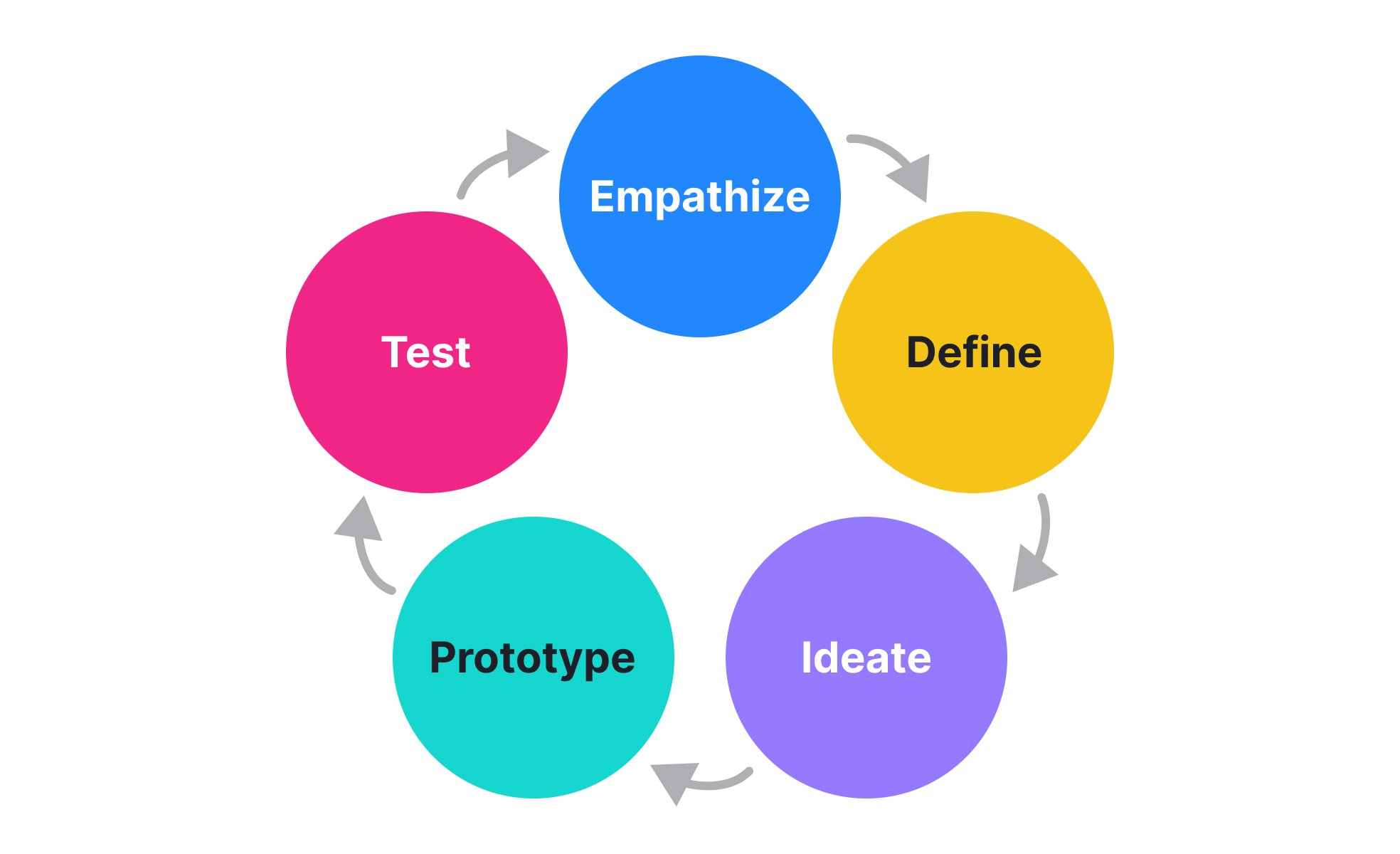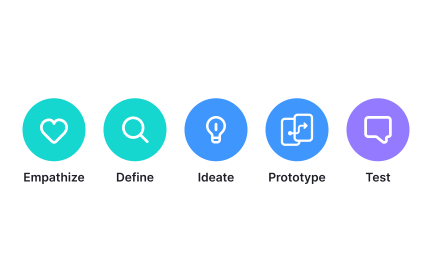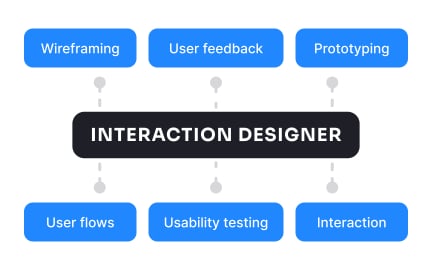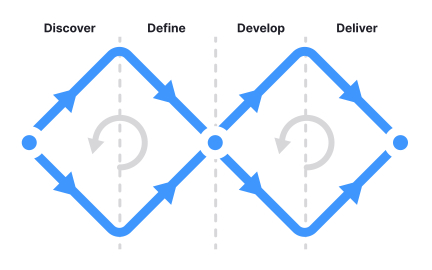Design Thinking
Design thinking is a practical, iterative approach to solving problems by focusing on user needs, rapid prototyping, while receiving constant feedback.

What is Design Thinking?
Design thinking is a human-centered problem-solving methodology that combines empathy, creativity, and rationality to understand user needs and develop innovative solutions that are desirable, feasible, and viable. It's a structured approach to innovation that prioritizes user research, iterative testing, and collaborative problem-solving over assumption-based decision-making and traditional linear development processes.
This framework encompasses empathy building, problem definition, ideation techniques, prototyping methods, and testing validation that enables teams to tackle complex challenges while maintaining focus on human needs and experiences.
Design Thinking in Product Development
Product managers use design thinking to ensure products solve real user problems while creating business value through systematic understanding of user needs, market opportunities, and solution feasibility.
User research and empathy building
Design thinking begins with deep understanding of user experiences, pain points, and unmet needs through observation, interviews, and immersion in user contexts. This prevents products based on internal assumptions rather than external reality.
Problem definition and opportunity identification
Teams use research insights to define specific problems worth solving while identifying innovation opportunities that create value for both users and businesses. Clear problem definition prevents solutions searching for problems.
Solution ideation and concept development
Structured brainstorming and creative thinking generate multiple solution approaches before selecting directions for development. This ensures teams explore various possibilities rather than implementing first ideas.
Rapid prototyping and user validation
Quick, inexpensive prototypes enable testing solution concepts with real users before major development investment. Iterative testing and refinement improve solutions while reducing risk.
Advanced Design Thinking Techniques
Empathy building methods:
- User journey mapping: Understanding complete user experiences including emotions and pain points
- Day-in-the-life studies: Observing users in their natural environments and contexts
- Extreme user analysis: Learning from users with unique needs that reveal universal insights
- Role playing and simulation: Experiencing user challenges directly through immersive exercises
Problem definition approaches:
- 5 Whys technique: Digging deeper into root causes rather than surface symptoms
- Problem laddering: Understanding problem hierarchy and relationships between different challenges
- Jobs-to-be-Done framework: Focusing on what users are trying to accomplish rather than demographics
- Constraint identification: Understanding limitations that shape solution space and opportunities
Ideation and creativity techniques:
- Brainwriting: Generating ideas individually before group discussion to increase diversity
- SCAMPER method: Systematically modifying existing solutions through Substitute, Combine, Adapt, Modify, Put to other use, Eliminate, Reverse
- Worst possible idea: Generating terrible solutions to unlock creative thinking and challenge assumptions
- Analogical thinking: Drawing inspiration from unrelated domains and successful solutions
Design thinking is a way of thinking and problem-solving that is centered around understanding the needs of people and developing solutions that are both functional and desirable. It is a process that is often used in the field of design, but it can be applied to a wide range of fields and disciplines.
Design thinking involves taking a human-centered approach to problem-solving, and it involves a series of steps that are designed to help you understand the needs of the people you are designing for, generate ideas, prototype and test solutions, and then refine and iterate on those solutions. It is an iterative process that involves a lot of prototyping and testing, and it is focused on finding creative, innovative solutions to complex problems.
The five stages of design thinking are:
- Empathize: This is the first stage of the design thinking process, and it involves understanding the needs, wants, and experiences of the people you are designing for. This might involve conducting research, observing users, and gathering insights.
- Define: In this stage, you take the insights you gained from the empathize stage and use them to define the problem you are trying to solve. This involves framing the problem in a way that is specific and actionable.
- Ideate: In this stage, you generate ideas for potential solutions to the problem you have defined. This might involve brainstorming sessions, sketching, or other creative techniques to generate a wide range of ideas.
- Prototype: In this stage, you take your ideas and create rough, low-fidelity prototypes. These prototypes are used to test and validate your ideas, and they can be physical, digital, or a combination of both.
- Test: In the final stage, you test your prototypes with real users to gather feedback and insights. This feedback is used to iterate and refine your designs, and you may go through several rounds of testing and iteration before arriving at a final solution.
Design thinking is important for a number of reasons:
- It is human-centered: Design thinking is focused on understanding the needs, wants, and experiences of the people you are designing for. This helps to ensure that the solutions you create are actually useful and desirable to the people who will be using them.
- It is iterative: Design thinking involves a lot of prototyping and testing, which allows you to iterate and improve your designs over time. This helps to ensure that the final solution is as effective as possible.
- It is collaborative: Design thinking involves bringing together people with a variety of skills and perspectives to work on a problem. This helps to ensure that a wide range of ideas are generated and that the final solution is well-rounded and comprehensive.
- It is focused on innovation: By encouraging a culture of experimentation and iteration, design thinking helps to foster a mindset of continuous improvement and innovation.
Overall, design thinking is a powerful tool for developing creative, innovative, and effective solutions to complex problems.
Here are some ways you can improve your design thinking skills:
- Practice: The more you practice design thinking, the better you will become at it. Try to work on as many design thinking projects as you can, and be open to trying new methods and approaches.
- Learn from others: There are many resources available that can help you learn more about design thinking, such as books, online courses, and workshops. Consider seeking out these resources and learning from people who are experienced in design thinking.
- Stay up to date: Design thinking is an evolving field, and it is important to stay up to date with new ideas and methods. Follow design thinking blogs and social media accounts, and try to attend events and conferences where you can learn from others in the field.
- Reflect on your work: Take time to reflect on the design thinking projects you have worked on in the past. What worked well? What could have been done better? This will help you to identify areas where you can improve and develop your skills further.
- Collaborate: Design thinking is a collaborative process, and working with others can help you to develop your skills. Consider joining a design thinking group or working on a project with others who are interested in design thinking.
Recommended resources
Courses

Design Thinking

Service Design

UX Research
Lessons

Design Disciplines

Intro to Design Composition

Lighting & Materials
Exercises
Projects

HireHarbour Allies: UX/UI Case Study for Inclusive Landing Page

Healthcare Solution for Older Adults












